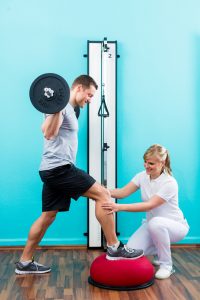Posted on March 21, 2018 by Jenny Cromack
Ieuan’s Insight Into Exercise Rehabilitation

Injury is something most of us experience at some time in our daily training/sporting lives. How we fix it is often put in the hands of someone else; a sports therapist, like myself, a physio, a doctors, a rehabilitator. We can fall into the trap of being a little passive with this and just letting them do what they feel right and we just robotically get on with it. If we, however, had a little more knowledge of key principles of exercise rehabilitation we may be able to start proactively helping ourselves and at times question or liasie with our rehabilitation experts. This brief article will highlight my approach to exercise rehabilitation (generally), and offer an insight into the principles we need to consider.
The first stage of rehabilitation occurs after any initial trauma has been dealt with. Usually about 72 hours+, after we have applied the POLICE principle (Protection, Optimum Loading, Ice, Compression, Elevation). The specificity of the rehabilitation plan is dependent on the type of tissues injured, for example a muscular strain rehab plan would differ slightly from a ligament sprain. The following offers insight into what principles need tackling at what stage.
Early Stage
In the early stage our focus should be on maintaining and pushing range of movement, maintaining some loading of the tissues through movement, and keeping the muscles “awake”. Depending on the injury severity these exercises will most likely be non- or partial weight bearing. As well as gentle stretching techniques, the range of movement exercises would simply be taking the limb through its normal movements in a non-weight bearing or partial weight bearing position. For example, in a knee injury we may guide a patient to sit on the floor and slide their knee back and forth so it bends and straightens in a pain free range. Additionally, we would want to contract the muscles isometrically (so no movement occurs), and squeeze the muscles for a given time, hold it, relax, and repeat. Alongside these range of movement exercises we would try, where possible, to maintain our cardio-vascular fitness. It may be that swimming is appropriate, a hand bike, or whatever doesn’t hurt or damage the injured area.
Mid-Stage
By this stage we should have relatively good range of pain free movement, and pain free partial, or full, weight bearing. Here is where we may push the range of movement exercises towards the end range, we may even begin to use tools to passively help it reach end range (e.g., bands, dowel rods, or manual therapy). Our muscular strength exercises here can become more weight bearing and we could begin to introduce some concentric exercises (muscles shortening as they contract) in an open-chain fashion. For example, in the knee we may introduce some leg curl or extension exercises and begin to gently and progressively load these up with bands or machines. It may also, be a good place to begin some partial-weight bearing, closed-chain exercises, such as supported squats which can be progressed to full weight-bearing or single-leg etc.
Here we would also want to introduce some proprioception work that includes balance, co-ordination, and reaction time. These things are important when regaining full dynamic stability and injury prevention. For example, we may begin with a two-foot stand for time, progress to a single-leg stand, then onto a cushion or wobble board.
Late Stage
The late stage is where the exercises become more challenging so we should now have gained full range of movement back and be pain free in full-weight bearing. In this stage we can progress the load and difficulty of the strength exercises. For example, we may begin to load up the squats, introduce other compound exercises, such as lunges, deadlifts etc. Additionally, we would want to introduce some full body exercises that include a multitude of mechanics to retrain core and whole body stability. An example may be, a lunge with a cable row or anti-rotation exercise. Additionally, here we would need to introduce some eccentric exercises (where muscle lengthens as it contracts), often called negatives. For example, here we may focus on the lowering of a deadlift to eccentrically contract the hamstrings, or introduce the challenging Nordic Curl.
This late stage is also where we would begin to introduce some stretch-shortening, power, work or plyometrics. These will be dependent on body parts, but should include exercises that create a stretching and recoil effect on the tissues. For example, a counter-movement jump or a hop-land-jump type exercise. Alongside all these exercises we would continue to progress the proprioceptive work by adding more unstable surfaces, reducing bases of support, and adding/removing stimuli. For example, we may close our eyes and re-run the balance exercises or have to react to stimuli such as catching and throwing whilst balancing.
Return to Play Stage
Finally, is the return to play stage. This is the stage most people forget because at this point they feel fully fit and normal again so will just go straight back to what they used to do. This stage is important for retraining sport/exercise specific skills. This stage would include exercises that follow the SAID principle (Specific Adaptation to Imposed Demands). Basically, we should put exercises in this stage that mimic the demands, movement patterns, and intensity of the sport/exercise we are returning to. For example, if we had an injured tennis player we may get them running through some agility drills that require similar lunge, hop-land, patterns that we had worked on previously but we would introduce the added stimulus of needing to react and play tennis shots or returns.
Although very brief I hope this article offers a small insight into the level of planning that is required to set up an exercise rehabilitation plan, and how important it is to follow a stage protocol to ensure we fully recover and prevent further injury.

